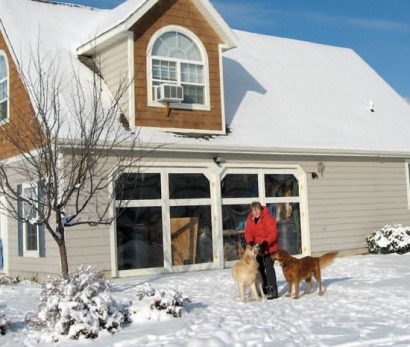
During design and construction, we experimented with various ideas to improve wintertime solar heating and insulation, summertime cooling and ventilation, and year-round energy efficiency. In retrospect, some of our ideas were not particularly successful, but other ideas worked well, perhaps inspiring other solar house builders to do the same.
Now that nearly 10 years have passed since our first experiment in solar housing, we have witnessed a virtual explosion in renewable energy experimentation among people like us – regular working folks who are concerned about saving energy while cutting costs, and who love to tinker in the workshop. The beauty of the Internet is that it has provided an electronic forum for these do-it-yourselfers to post their creations and to exchange ideas.
One of the most popular Internet sites for renewable energy do-it-yourselfers is Build It Solar, a noncommercial renewable energy site belonging to Gary Reysa. A former product development engineer for an aircraft manufacturer, Reysa became interested in do-it-yourself projects after moving into a big house in Montana that was “about as bad a solar design as one could imagine.” Having difficulty finding you-build-it resources on the Internet, he created his own site. Today, Build It Solar is one of the world’s most popular do-it-yourself websites, receiving about 12,000 visits a day!
Reysa’s website currently features around 1,400 stories and reports on a wide variety of homespun renewable energy projects. Asked about the most interesting do-it-yourself project on his website, Reysa says:
It’s hard to choose just one, but one of the most interesting is a project to convert a garage that has a south-facing overhead door into a solar-heated and lighted workshop, studio, or playroom using readily available materials and hardware, all for around $400 (see photo). The solar collectors are a set of custom-built glazed doors (about 80% glazing) mounted to the existing garage door frame, just outside of the garage door itself. The thermal mass of the floor absorbs the sun’s heat energy and then slowly distributes the heat inside the structure. An optional screen made of greenhouse shade cloth reduces daytime glare, and by closing the original garage door at sunset, nighttime heat loss is minimized.
Another intriguing Build It Solar project – there are so many – involves a clothes dryer setup that uses an attic solar collector for the hot air supply. This system saves the energy associated with heating air for clothes drying and also the energy required to heat or cool the air that a normally connected dryer pulls into the house as it vents air outside. The parts of this system are all very inexpensive, including the dryer, which can be found at a garage sale for under $50.
One of Reysa’s ideas, the Half Plan, has gotten a lot of attention in the press. By following some simple, low-costs steps, the Half Plan can help homeowners cut their energy use, energy costs, and greenhouse gas emissions in half with no significant lifestyle changes. Writing in Mother Earth News about his own experience with the Half Plan, Reysa notes:
When you start looking at any group of energy saving projects, you’ll likely find a huge difference in the bang for the buck. In our case, it was the simple things – such as controlling the amount of power that our computers use or basic insulating projects – that had especially good paybacks. On the other end of the spectrum, the solar photovoltaic project we intend to do in the future will cost as much as all 22 of our other projects put together, yet will only account for 2.5 percent of the total energy reduction!
My wife and I now live in a townhouse – a poorly insulated, 40-year-old structure adjoining other units in a big development. We have taken steps to make our unit more energy efficient, and we are proud of the progress we have made in reducing our utility bills. As with our solar house, we are experimenting again, but this time with downsizing. Our utility costs are far less than when we lived in a bigger house, and the small size of our unit has forced us to get rid of all the junk we have collected over the years.
We think downsizing is a good idea as we begin planning for retirement, and whenever the homeowners association takes care of lawn mowing, gutter cleaning, and roof repair, we celebrate our independence from these mundane chores. Even so, we miss the thrill of inventing and testing some new solar design or contraption. Do-it-yourselfers have all the fun!
Richard Crume works as an environmental engineer and teaches a university course on air pollution, climate change, and renewable energy. He has no financial interests in the Build-It-Solar website.

